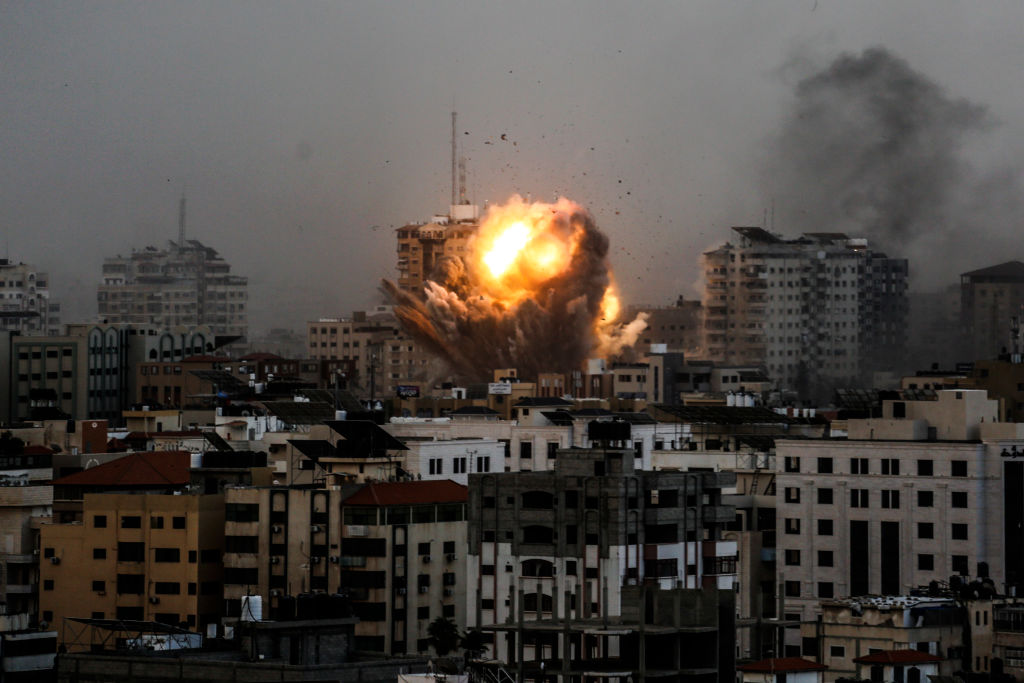
As Israeli military forces prepare for a ground assault on the Gaza Strip in response to the brutal Hamas terrorist attack on Oct. 7, the history of Israeli counter-terrorism, invasions, and assassinations suggests that these actions could backfire and result in an even greater threat emerging from the rubble.
The massacre by Hamas, which killed more than 1,000 men, women, and children, was an example of how that can happen. The terrorist group’s roots and strength date back to a Palestinian uprising that began in 1987—known as the first Intifada—when Israel turned a blind eye to the rise of Hamas so it could focus on what Israeli leaders saw as an even greater threat at the time: secular Palestinian groups, such as the Palestine Liberation Organization (PLO) led by Yasser Arafat.
This move proved to be a disastrous miscalculation. The Israeli campaign against the PLO in the 1980s ended up enabling the rise of both Hamas and the Lebanese Hizballah (Party of God), two non-state actors that currently threaten Israeli security. Israel’s military campaign might weaken Hamas. Yet, Israel is unlikely to destroy the terrorist group—just as it never destroyed the PLO—and may instead encourage the rise of a group far more threatening than Hamas.
Beginning with the foundation of Israel in 1948, the PLO provided the de-facto leadership for Palestinians, many of whom had been displaced by the Arab-Israeli wars first in 1948, and then again in 1967. Palestinians turned to the group once they realized they could no longer rely on nearby Arab states like Egypt and Syria to liberate what they saw as their land.
First from Jordan and then from Lebanon—after the PLO was expelled from Jordan in 1970—the group conducted military strikes against Israeli targets. In 1982 and 1983, an Israeli military operation chased the PLO from Lebanon to Tunis—far from Israel’s borders. Israel’s military campaign, however, spawned the creation of a Shi’a resistance group in Lebanon called Hizballah, which later inspired the creation of Hamas.
In 1987, the first Intifada erupted as a spontaneous, homegrown protest movement. Some of the Intifada’s leaders, disillusioned with the secular PLO, formed Hamas (“Courage”)—a more hardline, religiously-motivated group.
Read More: Here’s How World Leaders Have Reacted to the Israel-Hamas War
Israel imprisoned Hamas’ leader, Ahmad Yassin, in 1989, but otherwise turned a blind eye to the group’s spread because it was a relatively minor threat to Israeli security, and Israeli leaders were focused on Arafat and the threat posed by the PLO.
In 1993, the first Intifada finally ended in a historic peace agreement signed by Arafat and Israeli Prime Minister Yitzhak Rabin. Known as the Oslo Accords, the agreement that President Bill Clinton helped broker promised to eventually lead to Palestinian statehood.
Yet, almost immediately, this “two-state solution” began unraveling.
In 1994, an American-Jewish settler living in the West Bank walked into a Hebron mosque and killed 29 Muslim worshipers, inflaming tensions. Then in 1995, another Jewish settler opposed to the Oslo Accords assassinated Rabin, just after he had addressed a peace rally. The loss of the prime minister removed a champion of peace from the top of Israeli politics. Finally, in 1996, an Israeli tunnel built under what Muslims know as the Noble Sanctuary or Haram al-Sharif, and Jews know as the Temple Mount, sparked Palestinian protests.
These events prompted a dramatic change in strategy for Hamas. The group became the first Muslim organization to embrace the use of suicide bombers. Its leaders had tired of waiting for a Palestinian state and understood that Israel had a superior military. They also recognized that the shock of the tactic would guarantee media coverage, sow fear, and push Israel to lash out.
Hamas’ decision ignited a spiraling cycle that destroyed the peace process and thwarted any attempt to create a two-state solution.
Israeli voters reacted to Hamas’ first two suicide attacks by replacing the incumbent, pro-peace Labor government with a more hawkish, Likud-led government helmed by Benjamin Netanyahu.
Initially, although Likud distrusted the deal with the PLO, Netanyahu promised to fulfill Israel’s commitments. The prime minister even agreed to withdraw Israeli troops from most of Hebron in January 1997.
Yet, further Hamas suicide bombings prompted Israel to postpone relinquishing the rest of the West Bank. Netanyahu blamed Arafat for these attacks, but the truth was that Hamas was a rival to the PLO, and Arafat could not curb them. Trying to would only have damaged his standing, because Palestinians wanted greater militancy. They had grown increasingly frustrated with a peace process that gave them no hope for freedom or even employment, as well as the building of new Jewish settlements on what Palestinians saw as their lands.
These frustrations erupted on Sept. 28, 2000, when Israeli general Ariel Sharon made a much publicized visit to the Muslim shrines atop the Temple Mount to demonstrate Israel’s sovereignty over this holy site. Enraged Palestinians launched a second Intifada.
Again, frustrations and violence on one side prompted the other to take a harder line. Israelis elected Sharon—the general who had sparked this uprising—as prime minister, which only further fueled Palestinian anger.
Palestinians were also frustrated with their own leadership. Arafat was now president of the Palestinian Authority (PA), which emerged out of the Oslo Accords as the governing body of the semi-autonomous parts of the West Bank and Gaza. But he had little credibility with his own people because of the PA’s corruption and ineptitude.
Read More: Which Israel Will Emerge After the Hamas Attack?
Hamas—aided by Hizballah in Lebanon—filled the void by sending suicide bombers to target Israeli civilians in shopping centers, a discotheque, and crowded busses. The group’s terrorists also shot Jewish settlers in the West Bank and Gaza and shelled Israeli cities and towns with rockets. Israeli troops responded by bombarding PA buildings, killing many Palestinian civilians.
Arafat could do little to control these attacks or the cycles of retribution they prompted.
In 2004, Israel assassinated Yassin, whom they had released from prison in 1997. His successor, Khalid Meshal, a more formidable and charismatic figure, distanced Hamas from Saudi Arabia and aligned it with Iran. Unlike the Saudis, Iran could provide the group with rocket designs and technology.
Arafat’s death later that year injected hope for the resurrection of the “peace process.” Palestinians elected a new PA president, Mahmud Abbas, who renounced armed resistance and hoped negotiations could produce a just two-state solution. In February 2005 Abbas and Sharon agreed to end the fighting. The fighting did not totally cease, but the second Intifada was now largely over.
By August 2005, Israel had withdrawn all of its troops and settlers from Gaza, leaving the Strip essentially self-governing. Yet, Gaza’s Palestinians never gained full autonomy. Israel continued to control the external perimeter (except Gaza's southern border, controlled by Egypt), its seaports, air space, and the passage of people and goods.
A crucial turning point came in 2006 when three-quarters of eligible Palestinians living in the West Bank and Gaza Strip turned out to elect a 132-member Legislative Council. In a shocking result, the Change and Reform list, whose members were associated with Hamas, took more than half the seats.
Although Hamas said it would negotiate with Israel, it wanted a 10-year truce. Pressured by the U.S. and Israel, the PA rejected the Hamas victory. Hamas and allied Islamist militias responded by expelling the military forces loyal to Abbas and taking charge of Gaza in 2007.
Catastrophically, the expulsions marked the end of control over Gaza for Palestinians committed to the peace process. It also ignited a joint Israeli-Egyptian blockade (Hamas is an offshoot of the opposition Egyptian Muslim Brotherhood), which tried to stifle Gaza economically.
This produced another cycle of Hamas attacks and Israeli retribution, fueling even more bitterness and warfare. Iranian technology and assistance made Hamas’ weaponry more sophisticated.
In May 2021, Israel’s eviction of Palestinians from the Shaykh Jarrah area of East Jerusalem sparked an even fiercer cycle of Hamas rocket attacks and Israeli counterassaults. Hamas projected itself as the defender of the Muslim holy sites in Jerusalem, which enabled it to outflank the rival PLO, which still controlled the West Bank.

This move illustrated how Hamas has taken advantage of Palestinian frustrations to gain power at the expense of rivals more open to peace. Each time the terrorist group strikes and Israel responds with force, Hamas gains allegiance from Palestinians. The terrorist group has also grown its popularity by providing education, hospitals, and social services where governance has collapsed.
This intermixing of governmental services with terrorism makes it nearly impossible for Israel to wipe Hamas out. It also increases the odds of civilian casualties, which will only worsen the vicious cycle in which Israel and the Palestinians have been engaged for decades.
And that’s precisely Hamas’ goal. An Israeli ground invasion of Gaza will create a new generation of Hamas sympathizers and recruits.
The law of unintended consequences has also demonstrated that even when Israeli military action weakens one foe like the PLO, it can also lead to the emergence of a greater threat in the future like Hizballah and Hamas. The strength of Hamas has controlled the growth of more violent factions in Gaza, notably Islamic Jihad and al-Sabarin, two militias even more loyal to Iran. But history shows that they too could benefit from an Israeli ground invasion by winning the support of Palestinians who blame Hamas for provoking Israel.
Nobody knows when—or if—this cycle of responsive violence will end. But we know that in the past, Israel’s aggressive counterterrorism and focus on the threat at hand helped fuel the rise of Hizballah and Hamas. To end this cycle, Israel needs a long-term strategy to address the root causes of terrorism, socioeconomic deprivation, failure of governance, loss of hope, despair, and anger among Palestinians. Israel’s failure to do so has led to thousands of deaths—and sadly promises many more to come.
Ibrahim Al-Marashi is associate professor of history at California State University San Marcos and co-author of A Concise History of the Middle East, 12th edition. Made by History takes readers beyond the headlines with articles written and edited by professional historians. Learn more about Made by History at TIME here.
More Must-Reads from TIME
- Why Biden Dropped Out
- Ukraine’s Plan to Survive Trump
- The Rise of a New Kind of Parenting Guru
- The Chaos and Commotion of the RNC in Photos
- Why We All Have a Stake in Twisters’ Success
- 8 Eating Habits That Actually Improve Your Sleep
- Welcome to the Noah Lyles Olympics
- Get Our Paris Olympics Newsletter in Your Inbox
Write to Ibrahim Al-Marashi / Made by History at madebyhistory@time.com
